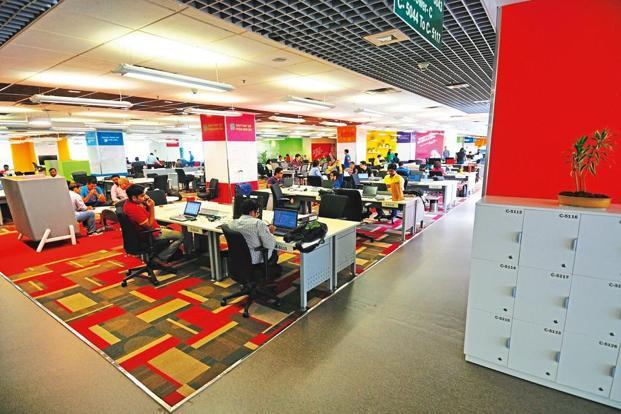
Open-plan workstations, with lockers for storage. Photographs by Priyanka Parashar/Mint
B. Srikanth is remarkably upbeat about the fact that he will soon be evicted from his spacious private cabin and relocated to a smaller open-plan desk, for the first time in his 30-year career. “I’m looking forward to it,” says the chief human resources officer of telecom firm Bharti Airtel, smiling. His colleague, Siva Sivasubramanian, the company’s global chief of security, transitioned from a private cabin to an open-plan workstation a few weeks ago.

B. Srikanth in his soon-to-be-demolished private cabin.After some “initial trepidation”, Sivasubramanian is discovering the benefits of working in a barrier-free environment alongside his junior colleagues. “After more than 20 years, I have come out of a cage. I used to say that I am in a cage because usually that’s the nature of the job. This (working in the open) allows better interaction, and for certain activities that require closed doors, there is a secure room,” he says, gesturing to an enclosed meeting room located near his desk, with a large safe meant for storing sensitive company information.
Inside-out reinvention
Srikanth and Sivasubramanian are just two of several dozen senior executives who will be eased out of their cabins, and into open-plan workspaces, as Bharti Airtel remodels its flagship Airtel Centre headquarters in Gurgaon, Haryana. All other employees, who were earlier seated in cubicles or had partitioned workstations, will also have open-plan desks. The phased floor-by-floor move, which began in February, is expected to be complete by March next year.

The remodelling represents one of the most ambitious attempts by a big Indian company to reinvent itself through its work environment. Most companies migrate to larger workspaces when the headcount expands, but Bharti Airtel is reconfiguring its existing six-storey facility to increase building occupancy and adopt new ways of working. The move will affect over 3,000 workers, 300,000 sq. ft of office space across all floors and, most importantly, signal a radical shift in organizational culture.The Airtel Centre refurbishment is underlined by three basic design principles. First, reduce hierarchies—within and between teams—by eliminating physical boundaries. All cabins, even the one for chief executive officer Gopal Vittal, are being abolished; partitions between adjoining desks are disappearing.
Instead, team members are seated facing each other, at clusters of desks, grouped in small sizes (of generally not more than 8-12), with sometimes a space for the team leader at the top of the table, dining-table style. The seating is unassigned: A business unit, for example, is allocated a particular section of the office for itself, and team members can choose a different desk for themselves every day within that section.
Each individual desk is now smaller. The resultant extra space has been used partly to accommodate more workstations and increase building occupancy by 25% (seeMission Reinvention). “We are actually consolidating three major offices outside this building into this one,” says Srikanth.

Meeting areas can be informal lounges or areas with bar-stools (pic below)

The second design principle entails a wider definition of “meeting”. A meeting is no longer restricted to a formal exchange in an enclosed room—it could be an informal conversation in a lounge, a bar-stool-style discussion at a high meeting table, or a larger group interaction in a room with whiteboards.
The space freed up has been utilized to provide more than eight types of work settings for group interactions, says Subhadarshi Mishra, head of real estate (projects). There are now 26 meeting rooms on each floor, instead of five earlier, as well as new collaborative spaces.

Technology is being used to support mobile ways of workingFinally, the design relies on effective technology to support more mobile ways of working, such as cable-free access to LED screens in meeting spaces, so office workers can connect their devices to presentation screens without worrying about whether the hardware is compatible.
Thinking digital at work
The impact on workflows is visible. While the currently unchanged fourth floor, with its partitioned workstations and cabins, is static and dull, the refurbished fifth floor throbs with energy. Animated group discussions punctuate the revitalized office landscape—with meetings taking place at high tables, in lounge chairs, conference rooms and on high-wall sofas.
Navin Shenoy, general manager (brand), calls himself a “convert”. Initially apprehensive about the lack of privacy, he now recognizes that the new office has “unleashed massive collaboration energy. The segregation between teams has gone, people are talking to each other a lot more,” he says.
Neelam Chhabra, head of facilities, too notes that “earlier, there were many complaints about meeting-room non-availability. I have not got a single complaint after the move to the (refurbished) fifth floor.”
Open-plan, cabin-free offices are trademarks of digital start-ups, but almost non-existent in corporate India, which generally holds on to organizational hierarchies. At Bharti Airtel, the team working on the company’s digital music app, Wynk, provided the impetus for change. “They said we need to have an atmosphere which reflects our intention, which reflects the fact that we are now a digital company. We started looking at designing a certain section for Wynk, but then we bit the bullet, saying it’s high time that the whole of Airtel really started breathing this kind of style, this kind of statement, not just new technologies but also new ways of working,” says Srikanth.
Ensuring efficiency
Open-plan offices, however, have generated some bad press, particularly in the West, where researchers have begun to characterize them as unproductive, suggesting that the gains in group collaboration are negated by the loss of individual efficiency owing to lack of audio and visual privacy.
Several design measures address these issues, says Debora Emert, design director for Nelson India, the architectural firm behind the Airtel Centre fit-out. “High NRC (noise reduction coefficient) rated acoustic panels over the open collaborative areas help reduce the amount of noise travelling into the general office space. And there are more enclosed meeting rooms to accommodate the louder, longer conversations that are most disruptive for the general- office occupant. The intent is that longer and louder conversations take place away from the individual workstation and in a collaborative or meeting zone,” she says.
The new layout was also validated by prototyping, pilot-testing and sustained employee engagement. “We went through 14 alterations, with two-three mock-ups being done in small locations. People worked on the (new) desks for 10 days and gave us feedback,” says Mishra. These user inputs resulted in smaller clusters of workstations, with more aisle spaces between them, and more randomly placed, unlike a cramped, rigid and noisy call centre. Employees also wanted a bigger writing surface, which has been provided on each table, on the walls of every column, and in meeting rooms, he adds.
With its striking exterior, the Airtel Centre attracted criticism and praise in equal measure when it was first built in 2010. Its new office serves as a reminder that inside-out reinvention can be a starting point for innovation. The refurbished facility also expresses a simple yet powerful idea: Design can bind people, spaces and work cultures, and architecture is the tangible tool that shapes the intangible contours of our daily lives.
Aparna Piramal Raje is the author of Working Out Of The Box: 40 Stories Of Leading CEOs, a compilation of Head Office columns, published as part of the Mint Business Series.
[“Source-Livemint”]

